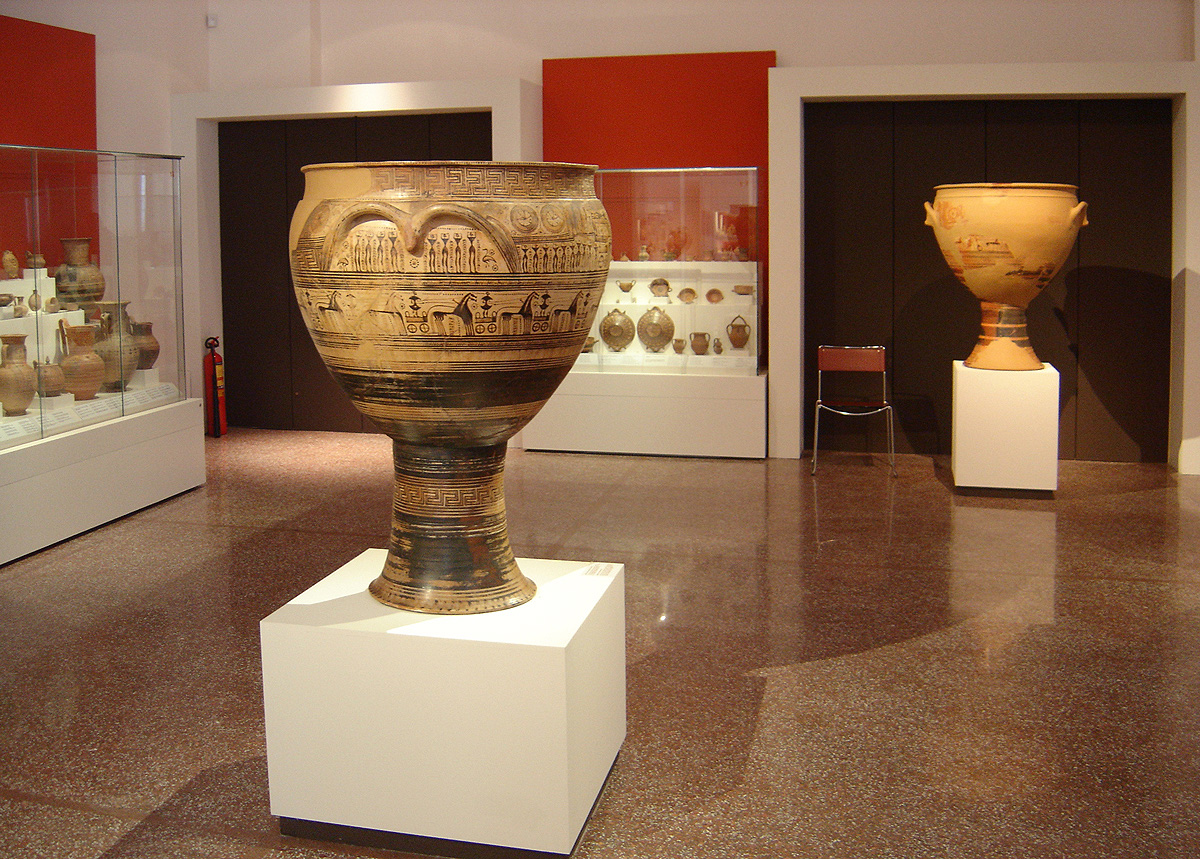
The Dipylon Krater is a key artifact of Geometric pottery that reveals early Greek art and burial traditions.
Key Highlights
Here are the main points about the Dipylon Krater:
- The Dipylon Krater is a large funerary vase from the Geometric period of ancient Greek pottery.
- These monumental vessels served as grave markers for wealthy individuals in ancient Athens.
- Its decoration features complex geometric patterns and the first narrative human figures since the Greek Dark Ages.
- Scenes on the krater depict funerary rituals, including the laying out of the deceased and a procession.
- Made by a skilled artist known as the Dipylon Master, it showcases the pinnacle of geometric vase painting.
The Dipylon Krater is a big and important piece in ancient Greek art. This large vase helps people see what made the geometric period special. It comes from the time right after the Greek Dark Ages, when art started to grow again. The Geometric period was important for ancient Greece and this krater is famous from that time. The detailed designs and stories on the vase tell us a lot about life, death, and old artistic ways in ancient Greece. If you want to learn more, you can follow its story.
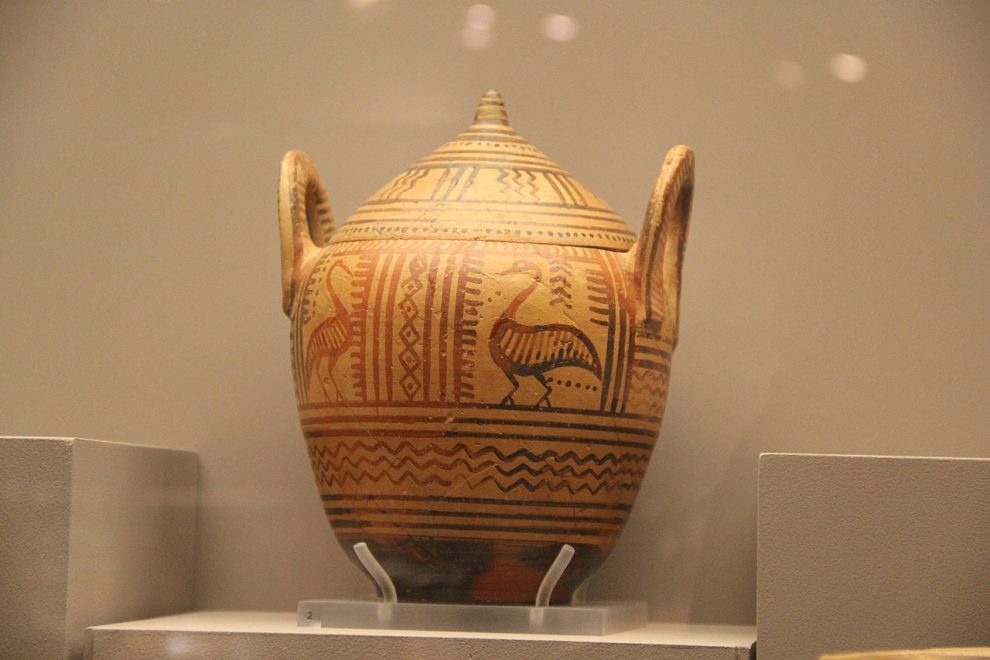
Image by: Gary Todd
The Historical Setting of Geometric Pottery
The Dipylon Krater is from a key time in ancient Greece called the geometric period. This time was around 900 to 700 BCE. The geometric period was the end of the Greek dark ages, a time when things were not growing and the culture was quiet. Slowly, a new Greek culture started to grow. There was more trade, more people, and the art started to get better again. Art from this time shows that people and the city-state, called the polis, became very important. In the next parts, we will look at the art styles that came up during the geometric period, and how things happening in society changed the design of pottery like the Dipylon Krater.
The Geometric Period and Its Artistic Developments
The geometric period gets its name from the style seen in ancient Greek pottery painting at that time. Potters and painters used geometric shapes to make patterns and figures. It is easy to spot the geometric style in the sharp lines they used for people and animal figures. A big change in pottery came with the fast wheel. By using the ancient Greek pottery wheel, potters had the way to create bigger and more even vessels. Because of this, they could make large pieces like the Dipylon Krater. The ceramic artists built these giant vases in sections, which showed how much skill they had.
Vase decoration was done by adding bands with the same shapes repeated over and over. Geometric art at this time stopped using only simple abstract designs found in the older Proto-Geometric period. Instead, artists started to add human and animal figures, but they still kept the shapes very geometric. This step was important for Greek art, as it brought new ways to tell stories through visuals.
Political and Social Contexts Influencing Pottery Design
The ancient city of Athens was the main place where Attic pottery was made at this time. There was a special spot there called the Kerameikos, known as the potter’s quarter. It was found near the Dipylon Gate on the northwest side of the ancient city of Athens. The cultural context and how the city was growing had an impact on Greek art and what people made. Before, art was about gods and myths. Later, the art of this period began to show everyday life, with a focus on people, especially the rich families. Funerary vases were used so these families could show their wealth and remember those they lost in public.
You can see how happy people in Athens were to live in the city, and how they wanted everyone to know about their success by looking at the scenes on the vases. On the Dipylon Krater, funerals are a part of the art, and they are meant for everyone to see. This link between art of this period and community shows us a lot about how people lived in the city of Athens and how important status was in ancient city of Athens.
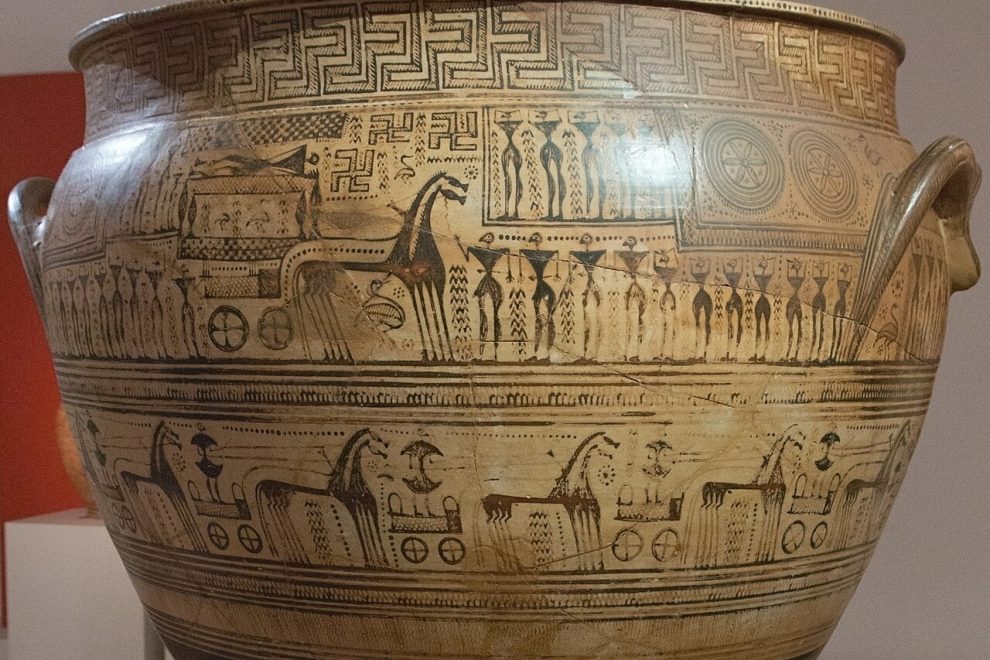
Image by: Zde
Origin and Discovery of The Dipylon Krater
Archaeologists found the Dipylon Krater in a large cemetery close to the Dipylon Gate in Athens. A krater is known as a large ancient Greek vase and people would use it to mix wine and water. In this place, the kraters had another use. They served as tall grave markers for the more well-known citizens of Athens. The krater itself shows us the story of how it was made and how people used it in ancient Greece. It is important to see where the krater was found and to know about the artist who is linked with making it.
Unearthing at Dipylon Cemetery
The Dipylon cemetery was just outside the city gates. It was the place where many people in Athens were buried. The big Dipylon Krater marked the grave of a man. He was probably a fighter or a respected leader from a rich family. Because the krater is so large and covered with detailed designs, it looks like his family spent a lot on making it. These large vases, called grave markers, were important during burial. People did not place them in the ground with the body. Instead, the krater stood above as a lasting sign for everyone to see. There was a hole in the bottom. This led many scholars to think that it was used for pouring drinks as offerings onto the grave.
Finding vessels like the krater helps us know more about how people honored the dead. The way these grave markers were made and shown off shows what the city felt about remembering people and why social status mattered so much in Athens.
Attribution to Workshop and Known Potters
Art historians believe the Dipylon Krater was made by an unknown painter, called the “Dipylon Master.” He was very talented and worked in Athens between 760 and 750 BCE. People do not know his real name, but there are about 50 other vessels in the same cemetery that show his style. His workshop was probably in the potter’s quarter nearby. The Dipylon Master focused on making large funerary vases. He had a special way to paint human figures during the geometric period. The people he painted had triangle bodies, big chins, and long, thin legs. He showed them in silhouette.
The idea of a “Master” and his workshop shows that pottery work in ancient Greek Athens was organized. This unknown painter did not just shape vases; he painted scenes that were hard to do. He helped start new ways of telling stories with art during the geometric period. His funerary vases had a big effect on ancient Greek pottery for a long time.
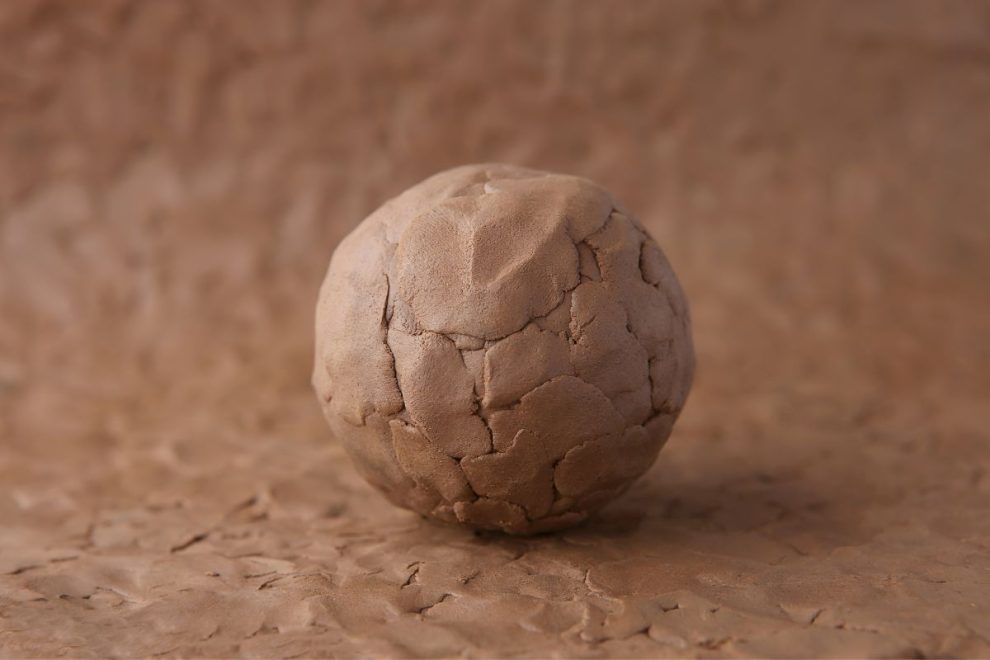
Structure and Techniques Used to Create The Krater
Making the Dipylon Krater took a lot of skill and a set way of working. Potters made this huge terra cotta pot by shaping parts on a wheel. They put the parts together after. This helped them keep the krater tall and well shaped. The geometric vase painting was done with care. The pot was fired in the kiln many times to finish it. The materials used and the way people made this ancient greek pottery show great ideas. The krater stands out because of the resources and the methods used to decorate it, showing a transition from earlier proto attic pottery methods.Let’s take a look at what went into the krater and how vase painting makes it different.
Materials Commonly Used by Ancient Greek Potters
The main material used in ancient Greek pottery was clay. People called it keramos back then. This clay could be found easily all over Greece. When someone wanted to make a big and complex item like the krater, they had to get the clay ready first. The potters let the clay sit in tanks so it could take on the right thickness for different parts of the vase. After that, the worker used a fast wheel to shape the clay. This was a new tool at the time and helped a lot. The krater was not done all at once. The artist made the foot, the body, and the neck in separate pieces. They then joined them with great care.
Because of this way of working, every large vase made each time had its own look. The pieces had to fit just right so that the finished krater would stand well and look even on all sides. The finished ancient Greek pottery showed the skill and control that the maker had with the material and tools.
Decoration Methods and Craftsmanship Details
After the vase was put together, the artist started to add decoration. He painted design on the vase before it went into the kiln. This decorative technique helped pave the way for styles like black figure Greek pottery and eventually ancient Greek red figure pottery.
You can see the artist’s skill in the careful geometric motif work. The surface is covered with different pattern bands, and you will notice the famous decorative meander, or Greek key. This repeated shape brings order and rhythm to the whole Greek pottery vase.
The artist used every bit of space possible. This shows planning and effort. His mix of shapes and story scenes needed a steady hand and a good idea of what he wanted. It shows just how much skill went into making it.
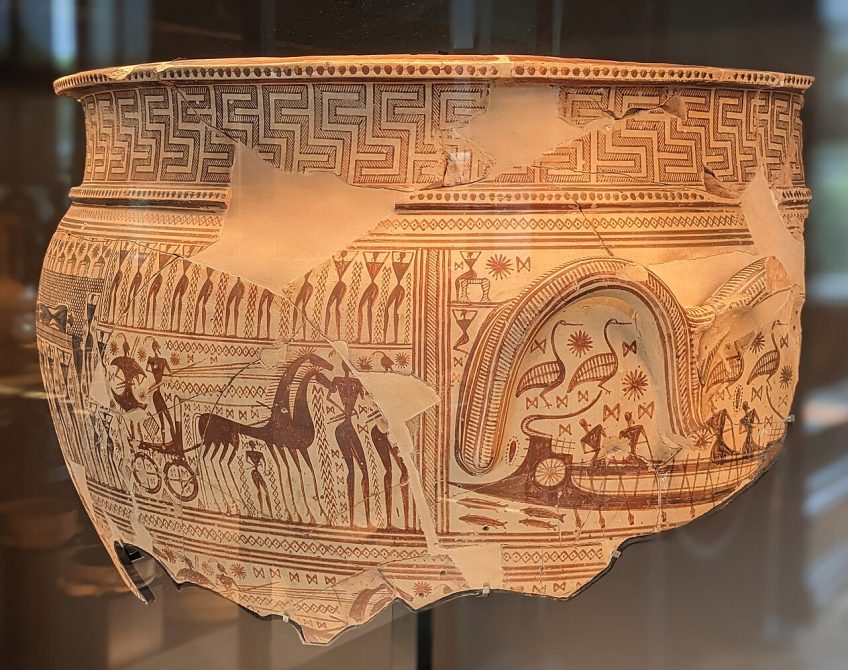
Image by: Shonagon
Visual Elements and Iconography on The Dipylon Krater
The Dipylon Krater shows geometric art on its surface. This vase stands out because of the thick, simple patterns that fill much of it. You also see human figures and animal figures in some scenes. The mix of these shapes and stories is what makes late geometric vase painting special. So, what do these patterns and figures mean? Let’s look at the ways they show us ancient Greek life and death. The designs and the scenes of people and animals tell us stories from that time.
Patterns and Motifs Typical of Geometric Art
A key feature of the krater’s decoration is how the artist uses horror vacui. That means the artist is afraid to leave any space empty, so the entire vessel is covered with lots of images. Every part of the surface has something on it. There is no blank space anywhere on the krater. This style makes the krater look busy and full of life.
Most patterns in the krater use geometric shapes. They are set in horizontal bands called registers. On the krater, you will often see these motifs:
- Decorative Meander: This is the famous Greek key design. The pattern comes from a continuous line that bends back and forth.
- Circles and Diamonds: These shapes help fill space inside the bigger bands.
- Checkered Patterns: Used on things like the burial shroud, these patterns give extra detail.
The patterns do more than just look nice. They form a base for the scenes with people. They also show the artist’s skill. The repeated geometric motif makes the entire vessel have unity and balance.
Figurative Scenes and Their Meanings
The most important part of the krater is the main scene that you see on its widest part. This part shows a prothesis. That is a ceremony in which the dead person is laid out so people can mourn. You can see the body lying on a couch. There are human figures next to it, on both sides. These people are drawn with triangle-shaped chests, and you can see they are pulling at their hair because they are sad.
Under this, another row shows an ekphora. This is a funeral march. In this one, you can see warriors with big shields shaped like hourglasses. They are next to chariots pulled by horses. These animal figures are simple, much like the human figures. They have easy, blocky shapes.
The scenes on these Greek painted vases were there to tell a story. The art helped remember the dead person, showed he might have been a soldier, and showed what kinds of funeral customs his family followed. This type of storytelling started in Greek art with vases like the krater, after a long time when people did not make this kind of art.
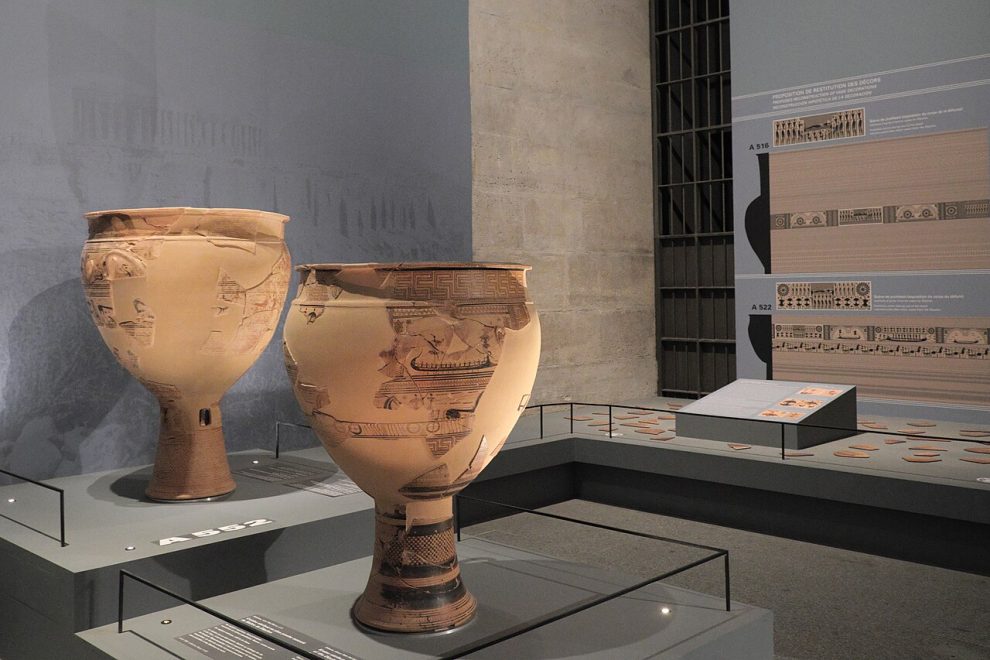
Image by: GFreihalter
The Dipylon Krater’s Role In Funeral Rituals
The Dipylon Krater was not made for parties. It was for death and memory, and acted as one of the most detailed grave markers back then. The krater was a big monument that showed everyone how important an Athenian man and his family were. The big size and the place it was put in the cemetery let people see the family’s loss and standing.
The way people were buried in ancient times helped to shape how this vessel looked and what it was used for. We can now take a closer look at how Athenians used these kraters and what they wanted others to know from the pictures shown on them.
How Athenians Used Kraters In Burial Practices
In ancient Greece, the funerary process had important steps. First came the prothesis, where the body was laid out. Then, there was the ekphora, when people moved the body to the grave. The pictures found on the krater show these burial traditions. People in ancient Greece thought these steps were needed for the soul to go into the underworld the right way.
The krater had a hole at the bottom. This hole meant it could be used for pouring votive offerings, like wine or oil, into the grave. This helped people keep showing respect and care for the dead even after burial. This way, they could keep their bond with their loved one who was gone.
Symbolism Behind Funerary Imagery
The pictures on the Dipylon Krater used for grave markers say a lot. The people in the scene hold their arms up and pull at their hair. This is a clear way to show deep sadness and loss. The artist shows many people doing the same thing. This helps everyone see that the whole group cares and feels grief over what has happened.
The row of fighters and chariots also means something. It shows that the person who has passed was part of the military. It also hints there that he was a hero. In the cultural context of ancient Athens, people looked up to strong soldiers. So, this kind of picture was a way to honor him.
In the end, all of this art on grave markers was a way for the family to send a clear message to others. It showed that they could give a grand funeral. It also let everyone know how important the lost person was. The pictures and symbols helped keep memories alive and let the people remember what mattered most in their world. It was their way to cherish a good life in the open.
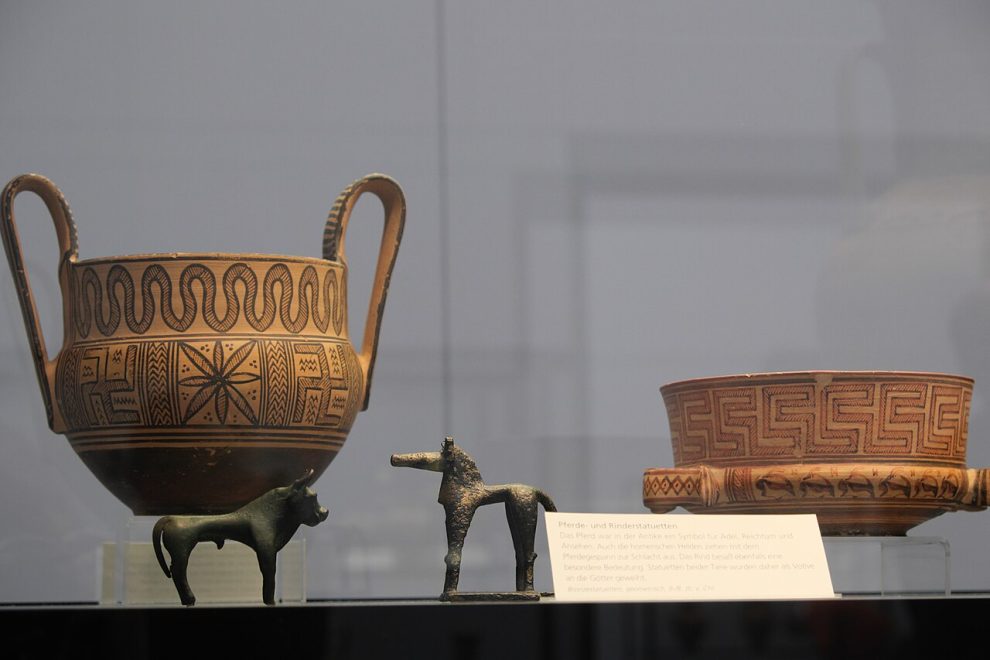
Image by: GFreihalter
Comparing The Dipylon Krater to Other Geometric Vases
The Dipylon Krater shows the style of the geometric period very well. It was the most famous, but it was not the only vessel made in this time. Potters made many different vessels back then, such as large amphorae and small geometric bronzes. When we compare the krater with these other vessels, we get to see all the ways Greek art was made in that year.
What makes the krater different, and what does it share with other vessels from the geometric period? The next sections will talk about these things. They will also show how the krater had an influence on greek art and other geometric bronzes made at that time.
Similarities and Differences with Related Vessels
During the Geometric period, different large vessels served similar commemorative purposes. The Dipylon Krater and the Dipylon Amphora are two of the most famous related vessels. Both were used as monumental grave markers and were decorated by the Dipylon Master in his signature style, featuring geometric patterns and funerary scenes.
The main difference between them lies in their shape and the gender they represented. Kraters, with their wide mouths, marked male graves, while amphorae, with their narrower necks and full bodies, marked female graves. This distinction was a consistent part of Athenian burial customs.
The table below outlines some key distinctions between these two iconic pieces.
| Feature | Dipylon Krater | Dipylon Amphora |
|---|---|---|
| Gender Marker | Male | Female |
| Shape | Wide, open mouth | Tall, narrow neck |
| Primary Scene | Prothesis and ekphora (procession) | Prothesis only |
| Handles | Small handles on the body | Handles on the shoulder/neck |
Influences on Later Pottery Styles
The Dipylon Krater brought big changes to greek art. By adding stories and people to its designs, the Dipylon Master helped greek art move away from simple shapes. This led to more real and detailed pictures in later pottery styles. Artists started to show events from human life, not just patterns. This was a big change.
After this, the Orientalizing period came. It got ideas from the Near East, but the need to tell stories was already started. In the Archaic and Classical times, potters kept making pictures of people better. This work led to styles like Attic black figure vase painters and Attic red figure vase painters.
The strength of the geometric style in greek art is about having order and showing stories. Later greek art and roman art changed a lot, but using pottery to share moments from life started with these early works. The way artists told stories with their pots was important for the future of art in the West.
Other Related Notable Vessels
There are a few well-known vessels that help us understand the Geometric style in art. Each vessel tells its own story and helps us learn about the time period.
Some of the most well-known pieces are:
- Hirschfeld Krater: This is another name for the Dipylon Krater. You can see it in the Metropolitan Museum of Art. It shows classic scenes like the prothesis, where the body is laid out, and the ekphora, a funeral procession with human figures.
- Dipylon Amphora: This large vase was created by the Dipylon Master. It marks a woman’s grave. The vase has a narrow neck and shows mourners standing around the body.
- Elgin Amphora: This vase is different from the other two. It was not put up as a grave marker, but buried with the body. The bottom does not have a hole. People likely filled it with wine for a funeral feast.
The geometric style stands out in these vessels. You will see the famous Greek key designs and many stylized human figures. All these pieces show us how people marked important events and showed their feelings. The Euphronios Krater comes from a later time and shows advanced techniques similar to white ground Greek pottery. This vase shows how art changed, building on the early geometric style with key elements like human figures and narrow neck designs.
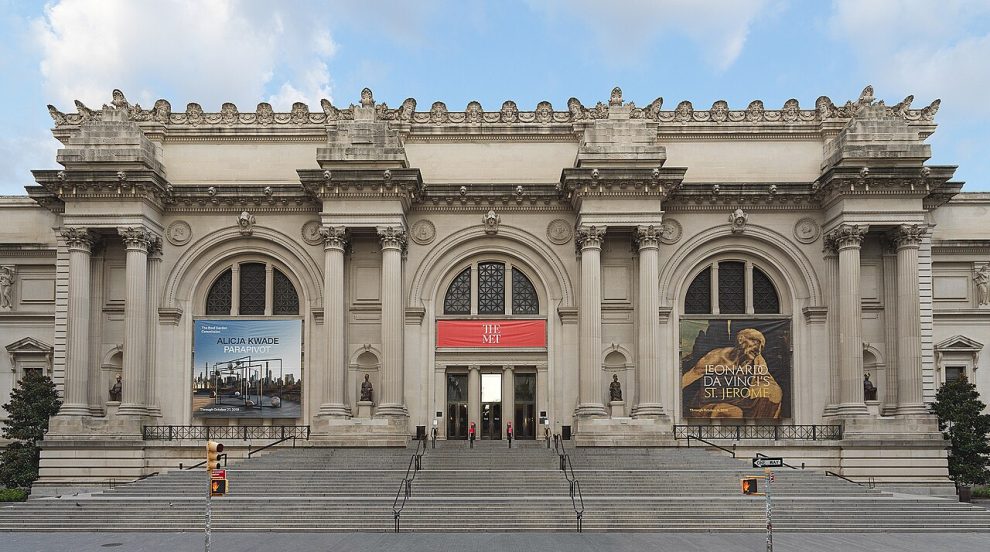
Image by: Hugo Schneider
Present-Day Importance and Where To See The Krater
Today, the Dipylon Krater is known as one of the most valuable items from ancient Greece. People say it stands out not just for its large size. The krater helps us know how life changed after the Greek Dark Ages. If you want to look at it, the krater and similar items can be found at top museums.
With new tools and work by museums, you may visit the krater, or learn more about it on the internet. Here is where it is kept and why it stays important for historians to study.
Major Museums Display and Preservation Efforts
You can see a well-known piece called the Hirschfeld Krater at The Metropolitan Museum of Art in New York., which also houses important ancient Greek vase shapes.There are other Dipylon vases too, like the Dipylon Amphora, which you can find at the National Archaeological Museum in Athens. These big museums work hard to keep these old and breakable pieces safe for the people who come after us.
Museums look after the ancient terra cotta by keeping them in carefully controlled rooms. This work by the museums helps us see and enjoy these things up close. Besides showing them in person, many of these places are also adding the objects to the internet.
- The Met Collection shares its object record and high-quality photos online.
- Many of their photos are free to use for noncommercial use since they are in the public domain.
- Some museums have started a virtual exhibition queue for their most popular web shows.
These steps help people all over the world see and learn about ancient art, whether you go to the museum in person or just look from home.
Why Historians Value This Artifact
The Dipylon Krater is very important to people who study history and archaeology. For them, the krater is a key source. It gives us some of the best and most complete information about the geometric period in ancient Greece. This is a time when we do not have a lot of writing. The krater shows how people made art, how their society was set up, and what they believed in when it came to gods.
The scenes on the krater also matter a lot. They show stories about people, which brings back a main interest in human life and what people went through. This helps set up the later growth of art in the West. You can find research centers all over the world using public domain images and open access data to look at the krater’s details. They do not have to be in the museum in person.
The krater helps to bring an international community of students, art fans, and scholars together as they learn more about ancient Greece. Its true value comes from more than just how old or beautiful it is. It lets us see, keep, and share the big history from this important time in culture. It is one of the best, real connections to our shared past.
Parting Thoughts
The Dipylon Krater is more than just an old pot. It is a big part of greek art and shows us a lot about geometric art in ancient greece. People used the krater as a grave marker. It is also one of the first to have story scenes on it. The krater shares a good story about new ways in art and how people talked about their lives. This special part of greek art helps us understand the people from ancient greece. It keeps giving us new ideas and connects us to the people who lived long ago.
